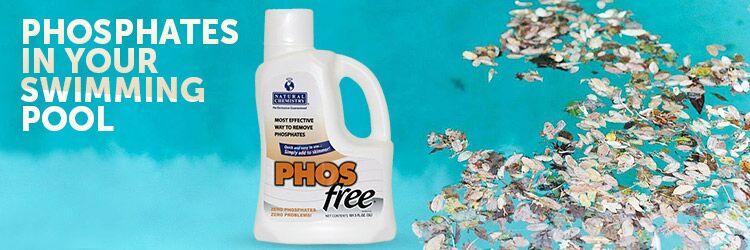It’s funny that we never hear customers complain about phosphates being in their pool until their pool is green. Did you know that phosphates are always in your swimming pool, even when there are no algal blooms? That’s because it doesn’t cross your mind when your pool is nice and blue. After reading through various articles and customers’ questions on removing phosphates, I’ve come to one conclusion, there’s a lot of misconstrued and misconceptions regarding phosphates in your swimming pool. What exactly are phosphates? Where do they come from and how do phosphates get into your swimming pool? What is the threshold for phosphates before it becomes harmful to the swimmer?
Let’s explore phosphates a little more.
What Are Phosphates?
 Phosphates are nutrients that help increase plant growth. Naturally, you can find phosphorus material all around. That is why it is common for phosphates to be in your swimming pool. But how exactly do phosphates enter your pool? There have been many debates suggesting how phosphates enter your swimming pool. Some argue that excess rainwater or fertilizer can affect your phosphate levels. Which is true, sort of.
Phosphates are nutrients that help increase plant growth. Naturally, you can find phosphorus material all around. That is why it is common for phosphates to be in your swimming pool. But how exactly do phosphates enter your pool? There have been many debates suggesting how phosphates enter your swimming pool. Some argue that excess rainwater or fertilizer can affect your phosphate levels. Which is true, sort of.
How Do Phosphates Enter Your Swimming Pool?
Phosphates might enter your pool one of several ways, but rainwater is not one of them. Rainwater itself isn’t phosphorous. In fact, it’s impossible as phosphates do not atomize in the atmosphere. However, once the rainwater runs off into the soil, then it becomes phosphorous. Usually, swimmers bring the majority of the phosphates into the pool with them. Contaminants like makeup, lotions, shampoos, dirt, leaves, and other pool chemicals like scale and stain products account for the majority of the phosphates in your pool.
When and How You Remove Phosphates From Your Pool
 Whenever you have an imbalanced pool, one of the first things you should do is test your water. Before you can remedy the issue, you first need to determine what the issue is, right? So what happens when the store clerk tells you your water has a high amount of phosphates? Naturally, the first thing pool owners do is go out and purchase a phosphate remover and add it into their pool.
Whenever you have an imbalanced pool, one of the first things you should do is test your water. Before you can remedy the issue, you first need to determine what the issue is, right? So what happens when the store clerk tells you your water has a high amount of phosphates? Naturally, the first thing pool owners do is go out and purchase a phosphate remover and add it into their pool.
If you’ve already experienced this, you already know that this won’t solve your green pool. Now, you have a green pool AND white sediment at the bottom of your pool. The first thing pool owners should focus on is removing the algae. In this particular case, once the pH and alkalinity levels were correct, the water was clear. To be honest, there probably wasn’t a need to purchase the phosphate remover. In most cases, you won’t have a need for phosphate remover.
In fact, there is no scientific evidence that even proves that phosphates actually increase algal growth rates when phosphate levels are below 1000 parts per billion (ppb). McGrayel Water Technologies completed a study and it was determined that algal growth rates are unaffected at each phosphate level. They also determined that phosphates are not likely to be a problem until after levels are above 1000 ppb.
Before adding phosphate remover into your pool, make sure you actually need it. We do not recommend adding unnecessary chemicals into your pool. Remove phosphates from your pool when levels exceed 1000 ppb. Once your phosphate levels exceed 1000 ppb, I would consider purchasing a phosphate remover. Keep in mind though, phosphate remover will not rid your green pool.
Reduce the high cost of removing phosphates by being proactive. Keep in mind, phosphate remover is preventative, not a remedy. Test and treat phosphates annually. There isn’t a need to worry about them constantly. Instead, focus more on keeping your pool properly balances.












Leave a Reply